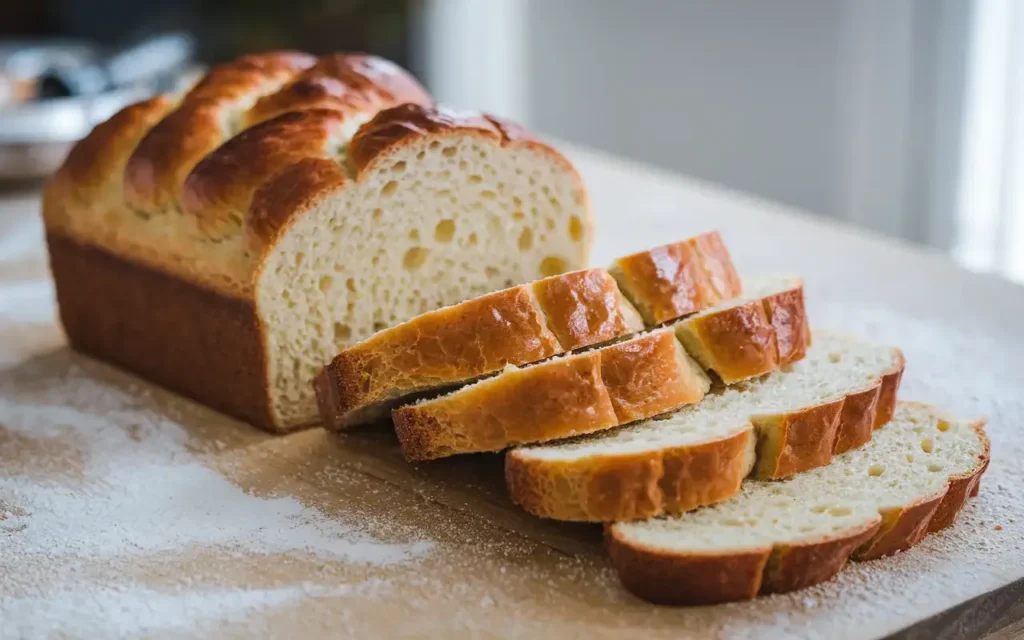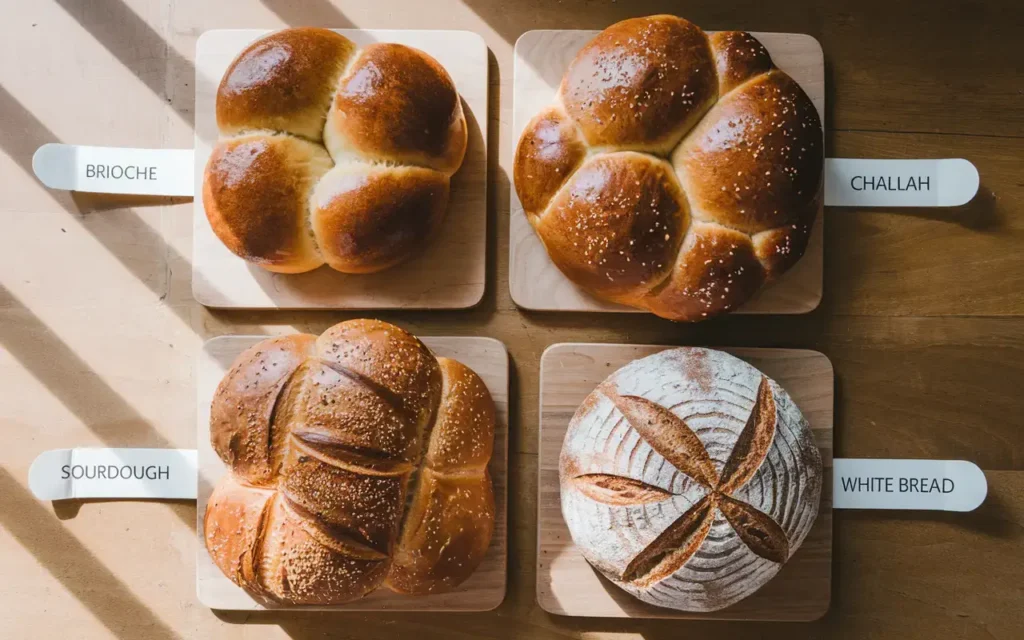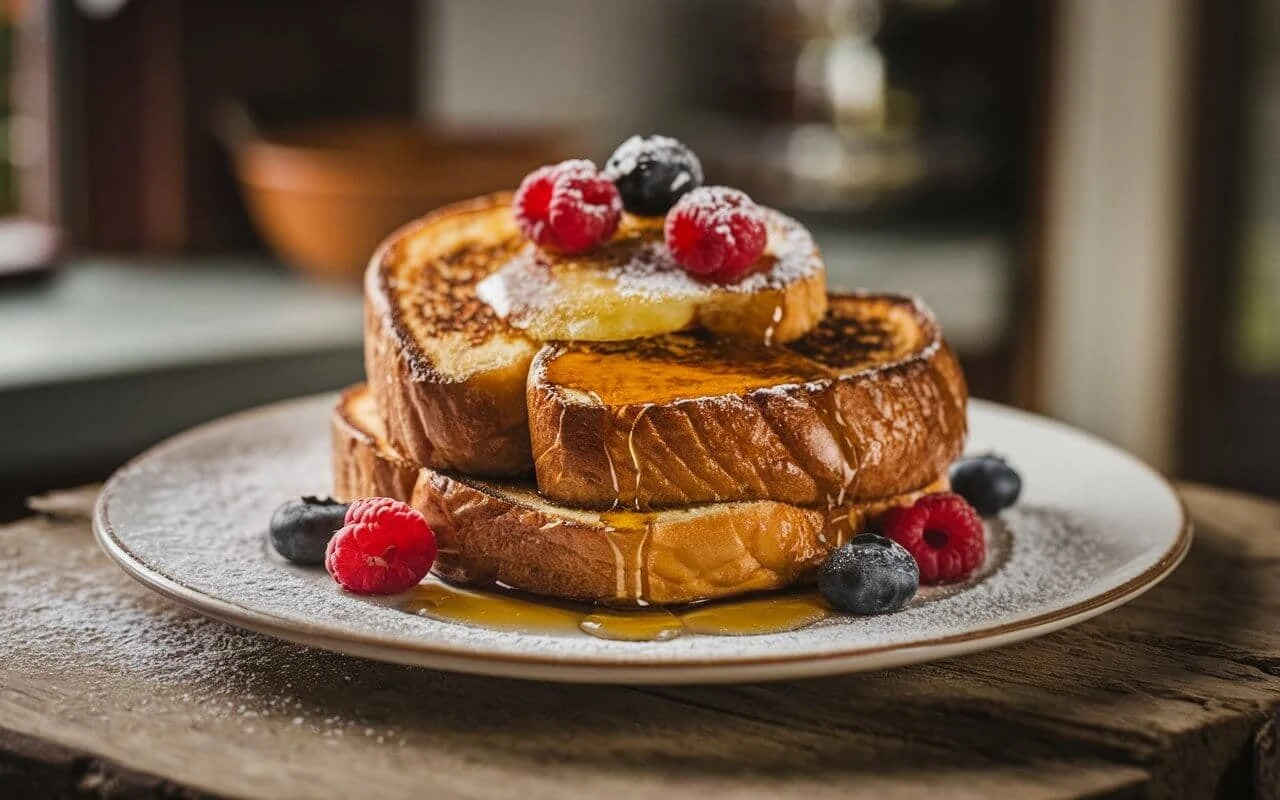French toast is one of those classic breakfast dishes that feels like a warm hug on a lazy morning. But not all French toast is created equal, right? The secret to an unforgettable plate often lies in the bread. If you’ve ever wondered why brioche is the go-to choice for many, you’re in the right place. Let’s dive into the delicious world of brioche and French toast!
Introduction to Brioche and French Toast
Ever bite into French toast that’s soggy, bland, or just… meh? It happens to the best of us. The bread you choose can make or break the dish. That’s where brioche steps in to save the day. With its rich, buttery goodness, it’s like French toast was made for brioche—or maybe brioche was made for French toast! But before we get too ahead of ourselves, let’s explore what makes brioche and French toast such a match made in culinary heaven.
What Is Brioche Bread?
Brioche isn’t just any bread. Think of it as bread’s fancy cousin who always shows up in a sleek outfit. This French delight is enriched with eggs and butter, giving it a soft, pillowy texture and a slightly sweet flavor. It’s like a cross between bread and a pastry—decadent but versatile. You’ll often find it in sweet or savory recipes, but trust me, its true calling is French toast.
The History of French Toast: A Culinary Classic
Now, French toast has been around for centuries—way longer than Instagram-worthy brunch spreads. Did you know it’s not even technically French? This dish dates back to ancient Rome! The term “French toast” likely comes from early American recipes, but across cultures, it’s been known as a way to revive stale bread with eggs and milk. Pretty clever, huh? And while any bread can technically work, brioche has emerged as the MVP for this timeless recipe.
Key Qualities of Brioche That Make It Perfect for French Toast
Let’s be honest: not every bread can handle the French toast treatment. You need a bread that’s sturdy enough to soak up the custard without falling apart but soft enough to feel luxurious with every bite. Here’s why brioche ticks all the boxes.
The Richness of Brioche: Eggs and Butter Content 🥚🧈
If bread were to join a talent competition, brioche would win “Best All-Around.” Its richness comes from eggs and butter, which make it dense but not heavy. This richness means it absorbs the custard mixture beautifully, resulting in a French toast that’s creamy on the inside but slightly crisp on the outside. No boring bites here!
Texture Matters: Soft Yet Sturdy Crumb
Ever dip bread into custard and have it turn into a soggy mess? Yeah, no thanks. Brioche has a tender yet sturdy crumb, meaning it holds up to the soaking process like a champ. It’s the difference between French toast that melts in your mouth and French toast that melts away before you can eat it.

Sweetness and Flavor Profile of Brioche 🍞✨
Brioche has this subtle sweetness that pairs perfectly with the rich custard and whatever toppings your heart desires—whether it’s maple syrup, powdered sugar, or fresh berries. It’s like it was born to be on your breakfast plate.
“Brioche doesn’t just support the flavors of French toast; it amplifies them, making each bite feel like a little celebration.”
Comparing Brioche to Other Breads for French Toast
Let’s take a quick detour and compare brioche to some other contenders for French toast glory. Spoiler alert: brioche almost always wins.
Brioche vs. Challah: Which Is Better?
Challah, another enriched bread, is a close second to brioche. It’s slightly less sweet and has a firmer texture. While challah makes excellent French toast, brioche’s buttery richness often gives it the edge for that indulgent, melt-in-your-mouth feel.
Brioche vs. Regular White Bread
White bread is like the “basic” option. Sure, it works, but it’s kind of… boring. It doesn’t have the richness or texture to stand out. Plus, it can get soggy fast. Brioche, on the other hand, feels luxurious and holds up beautifully. Once you’ve tried it, there’s no going back.

Alternative Breads: Pros and Cons
Some people like experimenting with sourdough, baguettes, or even banana bread for French toast. These can be fun, but they come with challenges—like sourdough’s tanginess or banana bread’s tendency to crumble. Brioche strikes the perfect balance between structure and flavor.
Common Problems with French Toast and How Brioche Solves Them
French toast isn’t without its challenges, but luckily, brioche has your back. Let’s tackle some common problems.
Soggy French Toast: How Brioche Helps Prevent It 🛠️
One of the biggest French toast fails is sogginess. Brioche’s structure ensures it absorbs just the right amount of custard without falling apart. The result? A texture that’s creamy, not mushy.
Lack of Flavor: Enhancing Taste with Brioche 🌟
Plain bread can leave your French toast tasting… well, plain. Brioche, with its buttery and slightly sweet flavor, adds depth without overpowering the dish. It’s like the bread is doing half the work for you.
Structural Issues: Why Brioche Holds Up Well
Thin, flimsy bread can tear when soaked, making cooking a nightmare. Brioche’s sturdy-yet-soft texture means it can handle a good soak and still hold its shape. It’s like the superhero of French toast breads.
How to Choose the Best Brioche for French Toast
Not all brioche is created equal. Choosing the right one can be the difference between good French toast and wow French toast. Let’s break down how to pick the perfect brioche for your breakfast masterpiece.
Fresh vs. Slightly Stale Brioche: Which Works Better?
This might surprise you, but slightly stale brioche actually works better for French toast. Why? Fresh brioche is soft and delicate, which can make it harder to absorb the custard evenly. Stale brioche, on the other hand, soaks up the custard like a sponge without turning mushy. If your brioche is too fresh, just leave it out for a few hours or lightly toast it.
Store-Bought vs. Homemade Brioche
Store-bought brioche is super convenient and works well if you’re in a pinch. Look for a loaf that feels soft but sturdy, with a slight shine on the crust. But if you really want to impress, homemade brioche takes French toast to the next level. It’s fresher, richer, and you get to control the sweetness and texture.
What to Look for When Buying Brioche 🛒
When shopping for brioche, keep an eye out for these features:
- Ingredients: Look for brioche made with real butter and eggs. Skip anything with too many preservatives or artificial flavors.
- Texture: The loaf should feel soft and slightly springy. Avoid overly dense or dry brioche.
- Shape: A classic loaf is ideal for slicing, but brioche buns or rolls can work for mini French toast bites.
Step-by-Step Guide to Making French Toast with Brioche
Making French toast with brioche isn’t just cooking—it’s an art. Follow this guide to create French toast that’s crispy on the outside, creamy on the inside, and bursting with flavor.
Ingredients Needed for Perfect Brioche French Toast
Here’s what you’ll need for 4 servings:
| Ingredient | Quantity |
|---|---|
| Brioche bread | 8 slices |
| Eggs | 4 large |
| Milk or cream | 1 cup |
| Vanilla extract | 1 teaspoon |
| Cinnamon (optional) | 1/2 teaspoon |
| Butter | For cooking |
| Maple syrup | For topping |
| Powdered sugar | For garnish |
Preparing the Custard: Key Tips and Tricks
The custard is the heart of French toast. Whisk together eggs, milk (or cream for extra richness), vanilla, and cinnamon in a bowl until well combined. Want to take it up a notch? Add a splash of orange zest or a sprinkle of nutmeg for a flavor boost.
“The key to a perfect custard is balance. Too much liquid, and your French toast gets soggy; too little, and it’s dry. Aim for a creamy, pourable consistency.”
Cooking Brioche French Toast: Achieving the Ideal Texture
- Heat a skillet or griddle over medium heat and add a generous pat of butter. Let it melt until it’s bubbly but not browned.
- Dip each slice of brioche into the custard, making sure both sides are coated. Don’t leave it in too long—just a quick soak will do.
- Place the soaked brioche on the skillet and cook for 2-3 minutes per side until golden brown.
- Transfer to a plate and keep warm while you finish the remaining slices.
Creative Variations on Brioche French Toast
Once you’ve mastered the basics, it’s time to get creative. Brioche French toast is like a blank canvas waiting for your culinary genius.
Stuffed Brioche French Toast Ideas 🥞✨
Why settle for plain French toast when you can stuff it? Try filling your brioche slices with:
- Cream cheese and strawberries
- Nutella and bananas
- Peanut butter and jelly
Cut a small pocket into each slice, stuff it with your chosen filling, and seal the edges before dipping in custard.
Toppings and Garnishes to Elevate Your Dish
The toppings are where you can really let your personality shine. Some crowd-pleasers include:
- Fresh fruit: Berries, bananas, or sliced peaches.
- Crunchy textures: Chopped nuts, granola, or crushed cookies.
- Decadent sauces: Chocolate drizzle, caramel, or fruit compote.
Pair Your Brioche French Toast with a Sweet Potato Cheesecake Twist
Looking to elevate your breakfast or brunch spread even further? Pair your indulgent brioche French toast with an equally decadent dessert like sweet potato cheesecake! This creamy, flavorful dessert brings a delightful balance of sweetness and texture that complements the richness of French toast. Imagine serving a slice of sweet potato cheesecake alongside your golden brioche French toast for an unforgettable combination that’s perfect for any gathering or special occasion. Plus, the cheesecake’s natural sweetness and smooth texture add a layer of sophistication to your meal. Ready to learn how to create this creamy masterpiece? Check out our detailed guide on making sweet potato cheesecake at AmoreRecipes. Whether you’re planning a festive brunch or simply treating yourself, this pairing will surely impress your family and guests. It’s the ultimate way to take your love for decadent treats to the next level!
Savory Brioche French Toast: A Unique Twist
Who says French toast has to be sweet? Try a savory version by skipping the vanilla and cinnamon in the custard. Add a pinch of salt, pepper, and herbs instead. Top with smoked salmon, avocado, or a poached egg for a fancy brunch option.
“Savory brioche French toast is like the cool cousin of the traditional version—unexpected, but oh so delicious.”
Frequently Asked Questions About Brioche and French Toast
When it comes to making French toast with brioche, a few common questions always pop up. Let’s clear up some of the mysteries and give you all the tips you need for success.
Can You Use Other Breads for French Toast?
Absolutely! While brioche is the gold standard, other breads like challah, sourdough, and even plain white bread can work. However, they might not deliver the same rich, buttery flavor and perfect texture that brioche brings to the table. If you’re in a pinch, any bread will do, but for a treat-yourself moment? Go with brioche.
Is Brioche Too Rich for Everyday Use?
Brioche is undeniably decadent, which might make it feel a bit indulgent for daily use. That being said, life is all about balance, right? Pair your brioche French toast with fresh fruit and a light drizzle of syrup, and you’ve got a breakfast that feels fancy but still manageable. For everyday use, you can always switch to whole-grain or less enriched breads.
Tips for Storing and Reusing Brioche French Toast
Got leftovers? Lucky you! Here’s how to store and reuse your French toast:
- Refrigeration: Store leftover French toast in an airtight container for up to 3 days.
- Freezing: Wrap slices individually in plastic wrap and freeze for up to a month. Reheat in the oven or toaster for best results.
- Creative Reuse: Cut leftover French toast into cubes and turn them into croutons for a sweet breakfast salad or layer them in a trifle with whipped cream and fruit.
Conclusion: Why Brioche Remains the Gold Standard for French Toast
So, why is brioche so good for French toast? It’s simple. Brioche has the perfect combination of richness, texture, and flavor to make every bite feel like a celebration. Whether you’re cooking up a quick breakfast or hosting an elaborate brunch, brioche French toast is a dish that always delivers.
“At the end of the day, brioche is more than just bread—it’s the key to turning a simple recipe into an unforgettable experience.”
Nutrition Facts for Brioche French Toast
Here’s a quick look at the approximate nutrition facts for a serving of brioche French toast (2 slices):
| Nutrient | Amount per Serving |
|---|---|
| Calories | 350 |
| Protein | 8g |
| Carbohydrates | 40g |
| Fat | 15g |
| Sugar | 10g |
| Fiber | 2g |
These numbers may vary depending on the toppings and garnishes you add. Want to make it a little healthier? Swap out cream for milk and skip the butter for cooking spray.
Final Thoughts
Whether you’re a French toast newbie or a seasoned pro, using brioche will take your breakfast game to a whole new level. It’s rich, it’s flavorful, and it soaks up custard like a dream. Next time you’re planning a brunch or just want to treat yourself, reach for a loaf of brioche and let the magic happen.

